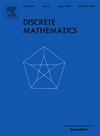Dense, irregular, yet always-graphic 3-uniform hypergraph degree sequences
IF 0.7
3区 数学
Q2 MATHEMATICS
引用次数: 0
Abstract
A 3-uniform hypergraph is a generalization of a simple graph where each hyperedge is a subset of exactly three vertices. The degree of a vertex in a hypergraph is the number of hyperedges incident with it. The degree sequence of a hypergraph is the sequence of the degrees of its vertices. The degree sequence problem for 3-uniform hypergraphs asks whether a 3-uniform hypergraph with a given degree sequence exists. Such a hypergraph is called a realization. Recently, Deza et al. proved that this problem is NP-complete. Although some special cases are simple, polynomial-time algorithms are only known for highly restricted degree sequences. The main result of our research is the following: if all degrees in a sequence D of length n are between and , the number of vertices is at least 45, and the degree sum is divisible by 3, then D has a 3-uniform hypergraph realization. Our proof is constructive, providing a polynomial-time algorithm for constructing such a hypergraph. To our knowledge, this is the first polynomial-time algorithm to construct a 3-uniform hypergraph realization of a highly irregular and dense degree sequence.
密集的,不规则的,但总是-图形-均匀的超图度序列
3-均匀超图是一个简单图的推广,其中每个超边是恰好三个顶点的子集。超图中一个顶点的度数是与它相关的超边的个数。超图的度数序列是其顶点的度数序列。3-一致超图的度序列问题是问具有给定度序列的3-一致超图是否存在。这样的超图称为实现。最近,Deza等人证明了这个问题是np完全的。虽然一些特殊情况很简单,但多项式时间算法只适用于高度受限次序列。我们研究的主要结果是:如果长度为n的序列D中所有度都在2n263+O(n)和5n263−O(n)之间,顶点数至少为45,且度和能被3整除,则D具有3-均匀超图实现。我们的证明是建设性的,为构造这样一个超图提供了一个多项式时间算法。据我们所知,这是第一个构建高度不规则和密集度序列的3-均匀超图实现的多项式时间算法。
本文章由计算机程序翻译,如有差异,请以英文原文为准。
求助全文
约1分钟内获得全文
求助全文
来源期刊

Discrete Mathematics
数学-数学
CiteScore
1.50
自引率
12.50%
发文量
424
审稿时长
6 months
期刊介绍:
Discrete Mathematics provides a common forum for significant research in many areas of discrete mathematics and combinatorics. Among the fields covered by Discrete Mathematics are graph and hypergraph theory, enumeration, coding theory, block designs, the combinatorics of partially ordered sets, extremal set theory, matroid theory, algebraic combinatorics, discrete geometry, matrices, and discrete probability theory.
Items in the journal include research articles (Contributions or Notes, depending on length) and survey/expository articles (Perspectives). Efforts are made to process the submission of Notes (short articles) quickly. The Perspectives section features expository articles accessible to a broad audience that cast new light or present unifying points of view on well-known or insufficiently-known topics.
 求助内容:
求助内容: 应助结果提醒方式:
应助结果提醒方式:


